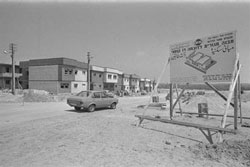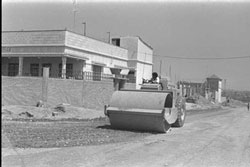• Why do Palestinians in Gaza still live in refugee camps? Did the Israelis force Palestinians to stay in the squalid, overcrowded camps?
Palestinians still live in refugee camps, even when the camps are in Palestinian Authority controlled areas, because the PLO opposes and prevents refugee resettlement. As the PLO slogan goes, A Palestinian refugee never moves out of his camp except to return home (ie, to Israel).
While the PLO has done its best to keep Palestinians in refugee camps, Israel has done its best to move Palestinians out of the camps and into new homes. Israel even started a heavily subsidized “build-your-own-home” program for Palestinian refugees. According to an early description of the program:
Nine new residential schemes have been built so far, housing some ten thousand families that have chosen to vacate the camps. Each family was given a plot of land with full infrastructure…
The new neighborhoods were built on state land within municipal areas near the camps, and each had an electricity network, water and a sanitation system … a road system, paved sidewalks and developed surroundings. Public buildings were constructed in each neighborhood such as modern schools, health clinics and shopping centers, and land was allocated for mosques.
… As soon as his house is built, the refugee becomes the full property owner, and in due course his property is registered in the Land Register. (Judea, Samaria and the Gaza District, 1967 – 1987; Israel, Ministry of Defense, 1987)
 |  |
| Sheik Radwan, Gaza: New houses for Palestinian refugees built by Israel. (1977, Moshe Milner) | Sheik Radwan, Gaza: Road construction in neighborhood built for Palestinian refugees by Israel (1977, Moshe Milner) |
The vacated homes in the refugee camps were taken down with the goal of eventually creating enough open space so that the camps themselves could be rebuilt as further new neighborhoods for the refugees.
It’s not surprising that the PLO vehemently opposed this program – after all, former residents of a refugee camp, now living in a nice home in a new neighborhood, would have a stake in supporting peace and opposing violence, exactly the opposite of the PLO’s strategy.
What is perhaps surprising is that the United Nations also opposed the program, and passed harsh resolutions demanding that Israel remove the Palestinians from their new homes and return them to the squalid camps. For example, UN General Assembly Resolution 31/15 of Nov. 23, 1976:
Calls once more upon Israel:
(a) To take effective steps immediately for the return of the refugees concerned to the camps from which they were removed in the Gaza Strip and to provide adequate shelters for their accommodation;
(b) To desist from further removal of refuges and destruction of their shelters.
Similarly, UNGA Resolution 34/52 of November 23, 1979 declared that:
measures to resettle Palestinian refugees in the Gaza Strip away from their homes and property from which they were displaced constitute a violation of their inalienable right to return;
1. Calls once more upon Israel to desist from removal and resettlement of Palestinian refugees in the Gaza Strip and from destruction of their shelters;
Perhaps thanks to this support from the UN, the PLO began threatening to kill any refugee who would move out of the camps. After a few such attacks, the build-your-own-home program died, and that is why there are still Palestinians refugee camps in Gaza.
• How does the UN define just who qualifies as a Palestinian refugee? And are the UN’s figures for the number of Palestinian refugees accurate?
The UN’s figures are notoriously inaccurate, first of all because of the organization’s curious definition of who qualifies to be considered a Palestinian refugee. According to the UNRWA website (the link to the paragraph below no longer works, but here is a link to a similar UNRWA statement):
Under UNRWA’s operational definition, Palestine refugees are persons whose normal place of residence was Palestine between June 1946 and May 1948, who lost both their homes and means of livelihood as a result of the 1948 Arab-Israeli conflict. UNRWA’s services are available to all those living in its area of operations who meet this definition, who are registered with the Agency and who need assistance. UNRWA’s definition of a refugee also covers the descendants of persons who became refugees in 1948. The number of registered Palestine refugees has subsequently grown from 914,000 in 1950 to more than four million in 2002, and continues to rise due to natural population growth. (emphasis added)
There are serious problems with considering descendants of refugees to be refugees themselves. Indeed, if one follows this definition, then the more than 500,000 Jewish refugees from Arab countries who came to Israel after 1948 were nonetheless still refugees even after receiving Israeli citizenship, as are all their descendants (since, in these claims, descendants of Palestinian refugees are themselves considered refugees, even if they have acquired citizenship, such as Palestinian refugees in Jordan). That is, there would be in Israel today at least 3 million Jewish refugees from Arab countries.
In addition, the UN definition contradicts international law, under which descendants of refugees are not considered to be refugees. Thus, under the 1951 Convention Relating to the Status of Refugees, a refugee is a person who:
owing to well-founded fear of being persecuted for reasons of race, religion, nationality, membe
rship of a particular social group or political opinion, is outside the country of his nationality and is unable, or owing to such fear, is unwilling to avail himself of the protection of that country; or who, not having a nationality and being outside the country of his former habitual residence as a result of such events, is unable or, owing to such fear, is unwilling to return to it.
There is no room under this definition for a descendant of a refugee to be considered a refugee. The UN got around this problem by creating a loophole – the usual refugee conventions do not apply to people receiving aid from UNRWA (and only Palestinians receive aid from UNRWA).
• Whatever the definition, are the UN figures for the number of Palestinian refugees accurate?
No, as the UN itself has admitted. For example, in the Report of the Commissioner-General of the United Nations Relief and Works Agency for Palestine Refugees in the Near East – 1 July 1997 – 30 June 1998, the UN concedes that:
UNRWA registration figures are based on information voluntarily supplied by refugees primarily for the purpose of obtaining access to Agency services, and hence cannot be considered statistically valid demographic data; the number of registered refugees present in the Agency’s area of operations is almost certainly less that the population recorded.
Since the refugee figures are based on “voluntarily supplied” information given for the purpose of obtaining services, such as financial aid and food rations, there is obvious incentive for people to falsely claim to be refugees to get services to which they are not entitled. Especially since, as previously stated, refugees don’t actually have to live in refugee camps.
There is also incentive never to report deaths of people considered to be refugees – since the rations for the deceased would be discontinued.
The results are predictable: sacks of rice and flour with the UNRWA logo are resold everyday by merchants in Arab marketplaces in, for example, Jerusalem and Gaza.
• Do most of Gaza’s residents live in refugee camps?
The short answer is no. Of the 1,275,000 residents of the Gaza Strip, the UN considers 961,645 to be refugees, but of these only 471,555 live in refugee camps. (Refugee figures from UNRWA as of March 31, 2005, Table 1.0 and Table 2.1. Since links for these tables no longer work, here are links to the updated Table 1.0 and Table 2.1, as of 30 June 2008.)
• Is Gaza “the most densely populated place in the world”?
Again the answer is no – many places in the world, some rich and some desperately poor, are more densely populated than Gaza. To cite just a few examples:
| Area | Population Density (persons/sq. mile) |
| Gaza | 8666 |
| District of Columbia | 9176 |
| Gibraltar | 11,990 |
| Singapore | 17,751 |
| Hong Kong | 17,833 |
| Monaco | 41,608 |
| Macau | 71,466 |
| Cairo | 82,893 |
| Calcutta | 108,005 |
| Manila | 113,810 |
| (Sources – Statistical Abstract of the United States, 2004-2005, Tables 18 and 1321; Demographia — Population Density: Selected International Urban Areas and Components ) | |
